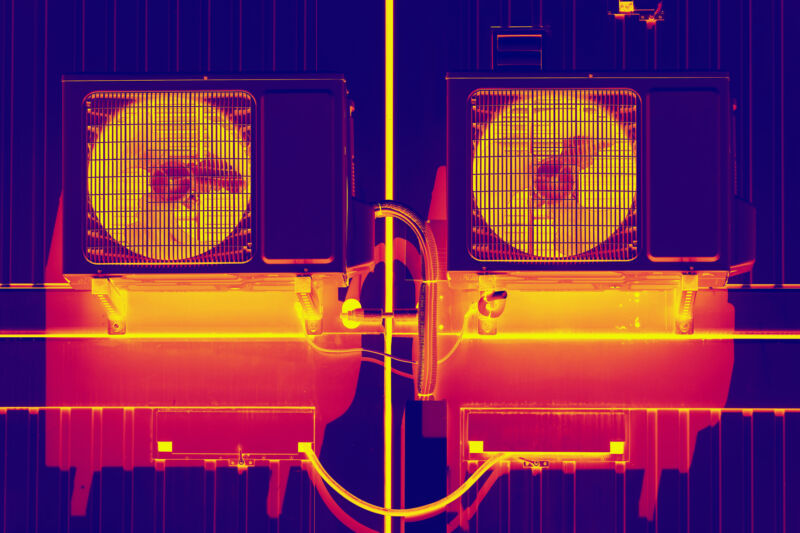beat the heat —
A new generation of engineers has realized they can push heat pumps to the limit.

Outside a 100-year-old house on the edge of the Peak District in northern England, a heat pump’s fan blades are swiftly spinning. They’re drawing outdoor air over coils of refrigerant, harvesting warmth from that air. All air-source heat pumps do this—and they can glean heat even on cold days. But this heat pump is special. It is one of the most efficient installations of its kind in the country.
“I’m number two on there,” fizzes owner Rob Ritchie, a retired chemistry teacher, referring to the system’s position on HeatPumpMonitor.org, a kind of online leaderboard for heat pumps around the UK and beyond. “I should say it isn’t important—but it is. It’s nice being there.”

At the time of writing, real-time data suggests that for every kilowatt-hour of electricity Ritchie’s heat pump consumes, it delivers 5.5 kilowatt-hours of heat—a coefficient of performance, or COP, of 5.5. Achieving a COP of 5 or above is “absolutely incredible,” says Emma-Louise Bennett, active transition support lead at Viessmann, the company that made Ritchie’s heat pump. In the UK, average heat pump COPs tend to be between 2 and 3.
For social-media-savvy plumbers and environmentally conscious home renovators who are increasingly sharing videos of their heating systems online, heat pumps are in vogue. In the race to decarbonize and curtail the devastating effects of climate change, switching home heating systems away from fossil-fuel-burning boilers and furnaces is essential. Heat pumps will be a key weapon in that fight, says the International Energy Agency. It estimates that, globally, heat pumps could reduce CO2 emissions by 500 million metric tons—equivalent to taking every car in Europe off the road.
A new generation of heating engineers has realized that they can push heat pumps to the limit. These installers are reaching astounding levels of efficiency by taking extra care to design low-temperature heating systems that warm rooms without using excess energy.
Heat pumps can offer multiple kilowatt-hours of heat per kilowatt-hour of electricity, thanks to physics. The refrigerant sealed inside the device evaporates readily when it is warmed even slightly, say by the outdoor air, and a compressor then pressurizes the warmed gas, which has the effect of heating it further. It only takes a little electricity to power this process, which can raise the refrigerant’s temperature by many degrees Celsius.
Since moving to his detached house near Sheffield about 10 years ago, Ritchie has installed loft insulation and solar panels, but the fabric of the building is not necessarily ideal for keeping the place toasty in an efficient way. The property has thin-cavity walls without much insulation in them, and Ritchie lives at 800 feet above sea level, meaning outdoor temperatures are generally relatively low. Thanks to his heat pump and solar panels, though, he estimates he’s now saving 2,700 pounds ($3,420) on his utility bills annually. It goes to show that heat pumps can work well in older properties in challenging locations, he says.
The system was designed by local installer Damon Blakemore, who also checks HeatPumpMonitor.org regularly to see how his work stands up against that of his competitors. Ritchie’s heat pump is not quite in pole position at present, but it is noteworthy, emphasizes Blakemore, because once a year’s worth of data has accumulated this September, it could be the first air-source device on the leaderboard to achieve a 365-day seasonal COP, or SCOP, of 5. This is an average that reveals how well a heat pump has performed over an entire year. Weather changes between summer and winter, which shift demand for heating, tend to affect overall system efficiency, among other factors.
Blakemore is one of the “SCOP-chasers,” as Bennett puts it, driven to maximize the efficiency of the systems he installs. There is a small but highly visible group of such people in the UK who follow each other on Facebook and X, drop in on each other’s podcasts, and jostle for high rankings on HeatPumpMonitor.org. Among the stakeholders in this race for efficiency is Heat Geek, an organization that has trained multiple high-performing installers—including Blakemore.
“It’s not really something we particularly anticipated,” says Glyn Hudson, cofounder of Open Energy Monitor (OEM), which runs HeatPumpMonitor.org, referring to the casual competition emerging in the heating industry. “But installers are proud of their work. They do enjoy showing off photos of their installations on social media. The pipework layout is very important to them.”